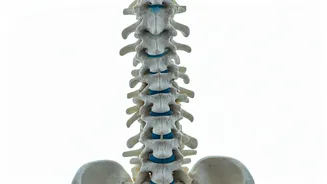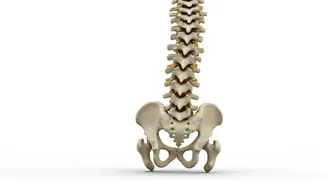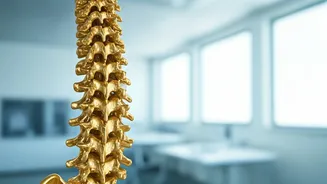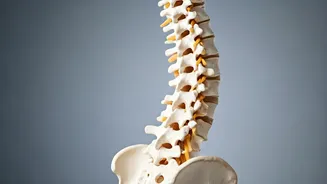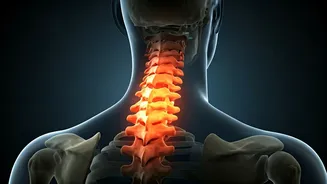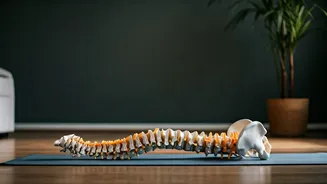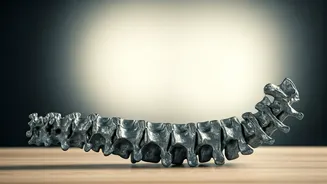The Spinal Structure
The spine, a complex system of bones, joints, ligaments, and muscles, serves as the body's central support structure, enabling movement and protecting
the delicate spinal cord. Understanding its structure is the first step towards maintaining its health. The spine is made up of 33 individual bones called vertebrae, separated by cushioning discs. These discs allow for flexibility and absorb shock. The spinal cord, a bundle of nerves, runs through the vertebral column, transmitting signals between the brain and the rest of the body. Maintaining a healthy spine requires paying attention to its components. This includes posture, movement, and the choices we make in our daily lives. This complex system is designed for both strength and flexibility. However, it's also vulnerable to various issues, including injury, degeneration, and poor posture. The vertebrae and discs, the ligaments and muscles all play critical roles, and their health is essential for overall well-being. By understanding the anatomy of the spine, we can begin to appreciate the significance of keeping it healthy.
Postural Impact Matters
Poor posture is a common contributor to spinal problems. Slouching while sitting, bending incorrectly, or standing with improper alignment can place undue stress on the spine, leading to discomfort and pain. Developing good posture habits is key for spinal health. Consciously monitor your posture throughout the day. Whether you're sitting at a desk, walking, or lifting objects, ensure that your spine is properly aligned. When sitting, sit up straight with your shoulders relaxed, your back supported, and your feet flat on the floor or on a footrest. When standing, keep your head up, your shoulders back, and your core engaged. The muscles in your back will also be able to support the spine. Be mindful of the way you move. Avoid any sudden, jerky movements that could strain your spine. This could include how you get out of bed. Proper ergonomics in the workplace is also vital to prevent spinal problems. A chair that supports the lower back and a desk at the right height can make a significant difference in your spinal health.
Exercise for Spine Health
Regular exercise is a cornerstone of spinal health. Exercise strengthens the muscles that support the spine, improves flexibility, and promotes overall well-being. Incorporating exercises that target the core, back, and abdominal muscles can help prevent and alleviate back pain. Consider exercises like yoga, Pilates, and swimming. They're all excellent options for spinal health because they promote flexibility, strength, and proper alignment. Incorporate these exercises into your routine. These help you build a strong foundation. Strength training also plays a role. It helps build core strength, and this allows for a more stable spine. Make sure to exercise with correct form to prevent any injuries. If you're unsure about the proper techniques, consult a fitness professional who can provide guidance and modifications. Always listen to your body and stop if you feel any pain. The frequency and intensity of exercise can vary based on individual needs and physical condition.
Nutrition and Hydration
What you consume plays a significant role in the health of your spine. Nutrition and hydration affect everything from bone density to disc health. A balanced diet rich in vitamins, minerals, and antioxidants supports bone health and reduces inflammation. Calcium and Vitamin D are essential for strong bones. Foods such as dairy products, leafy green vegetables, and fortified foods are excellent sources. Staying hydrated is also very important. The spinal discs are made up of mostly water, which provides cushioning and flexibility. Dehydration can lead to disc degeneration and increase the risk of back pain. Consume plenty of water throughout the day to keep your discs hydrated. Maintaining a healthy weight also reduces stress on the spine. Excess weight places additional strain on the spinal structures, increasing the risk of pain and injury. By adopting a healthy diet and staying hydrated, you'll be investing in the long-term health of your spine.
Mindful Movement Habits
Be mindful of how you move in your daily activities. This means paying close attention to your posture when lifting objects, bending, and sitting. Always bend at your knees and keep your back straight when lifting something. Avoid twisting your torso while lifting. Instead, move your feet to change direction. Also, make sure to use the right equipment to help. Use a chair that supports your lower back while sitting, and also ensure the height of the desk is correct. Incorporate micro-breaks throughout the day if you work at a desk. These can prevent stiffness and fatigue, reducing stress on your spine. During these breaks, stand up, stretch, and walk around. Regular stretching helps to maintain flexibility and reduce tension in the muscles supporting your spine. The practice of mindfulness can extend to movement. This includes being aware of how your body feels and avoiding movements that may cause pain. These habits, when incorporated into your daily life, will contribute to a healthy spine.
Seeking Professional Help
If you experience persistent back pain or any other spinal symptoms, don't hesitate to seek professional help. Consulting a healthcare provider, like a physician or a physical therapist, is vital for diagnosis and treatment. They can assess your condition and recommend the most appropriate course of action. This may include physical therapy, medication, or, in some cases, more specialized treatments. Physical therapy is one of the effective treatments available. It often involves exercises and techniques aimed at strengthening the muscles supporting the spine, improving posture, and reducing pain. Another method is chiropractic care. Chiropractors focus on the alignment of the spine and use adjustments to alleviate pain and improve function. When choosing a healthcare provider, look for someone experienced in treating spinal conditions. It's important to communicate openly with your healthcare provider. If you have any questions or concerns, discuss these with them to help you navigate your treatment plan.
